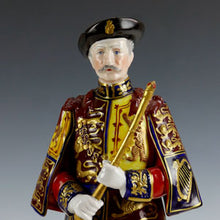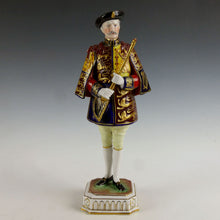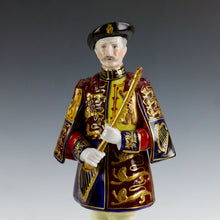Ulster King of Arms, Sir Neville Wilkinson, K.C.V.O., 1937
- Regular price
- £900
- Sale price
- £900
- Regular price
-
- Unit price
- /per
Sale
Sold out
Tax included.
Adding product to your cart
Mid 20th Century
Height: 27cm (10.5in)
Modelled as Major Sir Nevile Rodwell Wilkinson, K.C.V.O.(1869-1940) in ceremonial dress of the senior Irish herald and registrar of the Order of St Patrick.
Sir Nevile Wilkinson was educated at Harrow and Sandhurst, and commissioned into the Coldstream Guards in 1890. He served in the Boer War and retired from the Army in 1907. He was appointed Ulster King of Arms in 1908, succeeding the disgraced previous office-holder Sir Arthur Vicars after the theft of the St Patrick regalia. From 1915 he saw further military service as a staff officer during the First World War. As a Coldstream Guards officer is highly likely he knew Major E.G. Christie-Miller (1880-1967) who in the 1920s and 30’s acted as an import agent for Sachsische Porzellan Manufaktur Dresden (the Dresden factory) which produced a fine range of military themed figures for several London retailers.
In his role as a senior herald, Wilkinson spent most of his time in London despite most of the records relating to his post as overseer of Irish heraldry and genealogy being held at Dublin Castle. However, by 1923, Wilkinson had begun visiting the Irish office regularly, which caused a minor political problem for the fledging Irish government for sixteen years. It was discovered around 1923 that the office of Ulster King of Arms had not been legally transferred to the Irish government and since the office was created by Royal Prerogative in 1552, the British government said that they could not transfer the office to Ireland. Eventually, the Irish government decided in 1930 to let Wilkinson continue his work until his death, at which point the office would be considered by the Irish government to have lapsed.
Wilkinson was also the designer of two famous dollhouses, Tatiana’s Palace, completed and inaugurated in 1922 by Queen Mary) and Pembroke Palace (completed in 1907). He was married to Lady Beatrix Francis Gertrude Herbert, first daughter of the 14th Earl of Pembroke in 1903.
Use left/right arrows to navigate the slideshow or swipe left/right if using a mobile device








